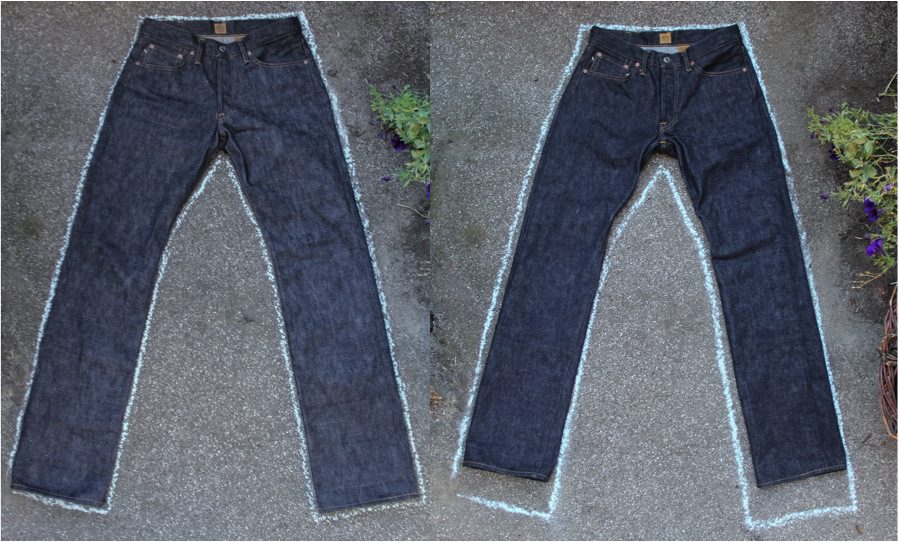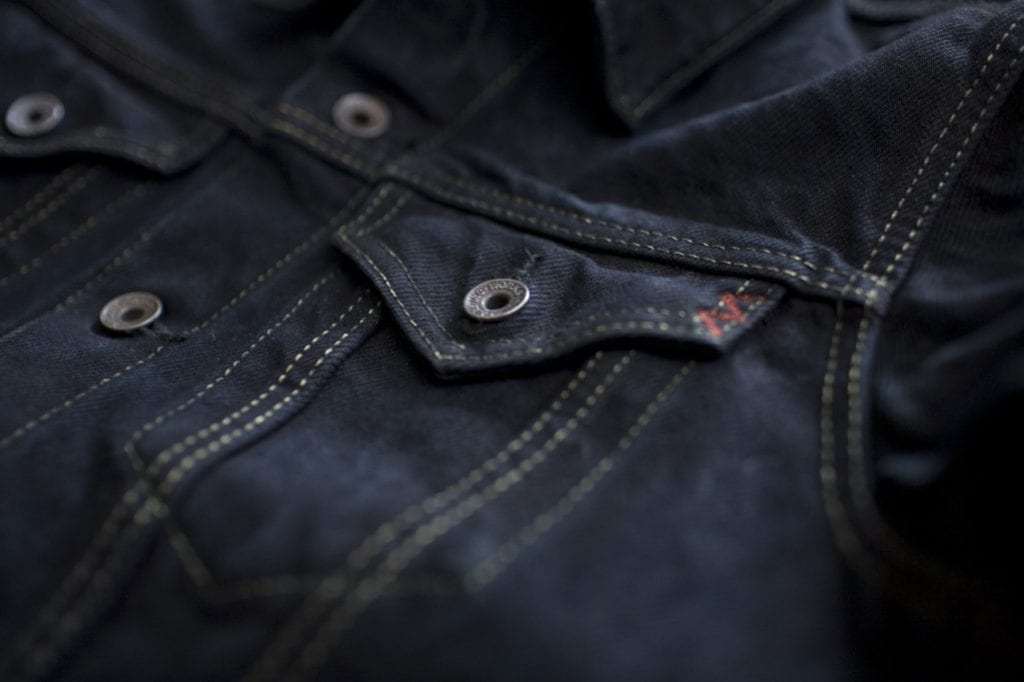Fabric finishing is the last stage in the production of denim. This is where the final touch is added, and it can make a big difference in how the fabric looks, feels and fades.
Fabric finishes are divided into two categories:
- Functional finishes are used to correct and prevent issues of dimensional stability
- Creative finishes enhance the look and feel of the fabric
Loomstate denim
Once denim comes off the loom, it’s known as ‘loomstate.’ Before fabric finishes were invented, all denim was loomstate.
This ‘unfinished’ denim doesn’t have any dimensional stability. Because the fibres are not shrunk back into their original state, the denim shrinks and the legs twist once the jeans are washed.
Fabric finishes were invented to prevent returns and customer complaints about these issues.

Almost all jeans have fabric finishing
Even most raw denim jeans are in fact finished in one way or the other.
Without any finishing, denim looks “hairy” because of all the excess cotton fibres that sit on its surface. The singeing process takes care of the “problem.” What’s much more important is that loomstate denim doesn’t have any dimensional stability. That means it shrinks like crazy.
Even though shrinkage didn’t stop denim jeans from becoming a major hit, denim makers figured they could make the experience of buying and wearing denim jeans more enjoyable by taking some of the guesswork out of it. So they developed fabric finishes.
Fabric finishing explained
A fabric finish is a treatment given to change the appearance, touch or performance of a fabric. The goal is to enhance the fabric beyond its natural state to make it better suited for whatever its purpose is.
Technically, fabric finishes are divided into two categories: functional and aesthetic. They either work to correct and prevent issues of dimensional stability, or to enhance the look and feel of a fabric with what’s known as creative finishes. The processes can be mechanical, thermal or chemical.
Functional fabric finishes
Fabric finishes that control dimensions are crucial because unfinished denim shrinks as much as 10%. The reason for that is summed up in one word: tension.
During spinning, dyeing and weaving, denim stretches in length and width as the yarn is under continuous tension.
If the fibres are not shrunk back into their original size before the denim is made into a pair of jeans, they’ll shrink once washed as the fibres relax and return to their regular length.

Sanforization
‘Pre-shrinking,’ also known as ‘sanforization,’ solves a fundamental problem of unfinished denim: it eliminates shrinkage.
You can read much more about sanforization and unsanforized denim here.
Pre-skewing
Once unfinished denim is washed and shrinks, it naturally skews in the direction of the twill line. Pre-skewing eliminates this issue.
Want to know more about pre-skewing, click here.
Heat setting
This fabric finish control the stretchability of stretch denim.
The fabric runs through a number of heat chambers, usually 8-12 chambers. The heat changes the molecular structure of the synthetic stretch fibres. This allows the denim maker to control the fabric’s elasticity.
The actual temperature varies, but for 10 oz. stretch denim you’ll need a temperature between 160°C and 200°C.
Creative fabric finishes
Regular ol’ blue jeans aren’t enough these days. The market constantly demands new colours, softer surfaces and great hand feels.
That’s why denim makers are continuously exploring new technologies to enhance the tactile and optical aspects of the fabric.
While a niche of enthusiasts want their denim as raw as possible, most consumers don’t mind if their jeans are a little softer or if they have a “special” look. And that look often comes from a creative fabric finish. Let’s explore some of the most common ones.
Singeing
The singeing process removes the excess cotton fibres that give unfinished denim it’s ‘hairy’ look. This is done by running the fabric quickly over a flame one side at a time. Most denim—even most raw denim—goes through this finish.
Click here to watch a video of how singeing works.
Mercerization
Unfinished denim has a characteristic rough and uneven hand feel. Enthusiasts love it, but most consumers don’t.
The solution often used is the chemical creative finished mercerization, named after its inventor, John Mercer. In mercerization, the fabric is treated under tension with a concentrated solution of caustic soda.
The finish opens the fibres and gives them a rounder shape, which makes the surface of the fabric smoother and increases the fabric’s lustre or shine. The finish is also used to prepare fabrics for further processing like overdyeing and coating, as it also enables the fibres to take in more dye.
For denim’s where mercerization gives a look that’s too flat and lustrous, the flat finish known as caustification is used. It’s sort of an in-between mercerized and unfinished denim.
Overdyeing and coating
Another common way to spice up the look of a fabric is adding a colour or a coat to it.
In overdyeing, the fabric is run through a bath of dye, which is then fixed by a steamer. A popular kind of overdye for denim these days is black sulfur on top of a warp-dyed indigo denim.

Coatings are for instance used to get a leathery look and feel. There are two types of coating methods. In knife coating, the coating material is deposited on the surface of the fabric and then the excess is scraped off with a blade. In foam coating, the coating material is turned into a foam and then sprayed onto the fabric. For both methods, once applied, the coating is fixed with heat.
At the end of the day, there’s hardly any denim that’s not finished one way or the other, whether it’s to enhance performance or aesthetics.
